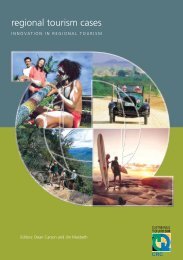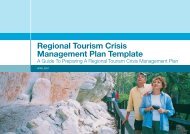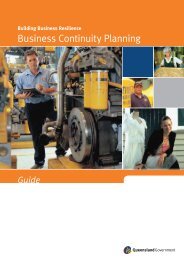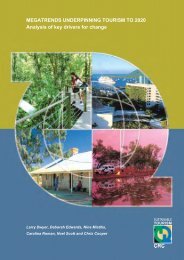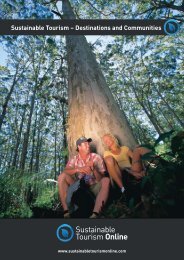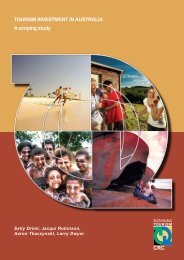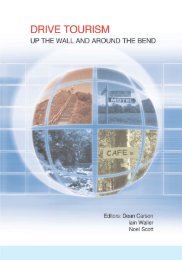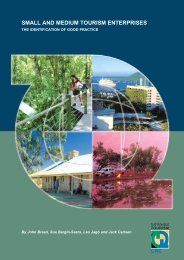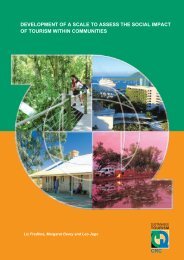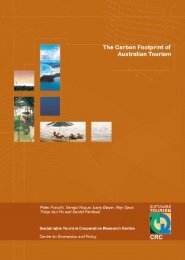Tourism Risk Management - Sustainable Tourism Online
Tourism Risk Management - Sustainable Tourism Online
Tourism Risk Management - Sustainable Tourism Online
Create successful ePaper yourself
Turn your PDF publications into a flip-book with our unique Google optimized e-Paper software.
C) Security for the future<br />
• Evaluate security procedures<br />
Following a crisis, it is necessary to re-assess security systems to ensure they are adequate.<br />
Security should be as unobtrusive as possible and not deter tourism from resuming. Use new<br />
security measures to reassure visitors of the importance you place on their safety and security.<br />
• Push to improve quality of services and facilities<br />
Encourage quality through feedback of survey results on visitor perceptions, by rewarding excellence<br />
and by setting up tourism complaint services. Visitors should have somewhere to complain if services<br />
do not meet expectations. Peru’s Visitor Protection Service (SPT), which operates under the<br />
auspices of the country’s consumer protection commission, provides this service by mediating<br />
complaints, providing general visitor information, and analysing data on the nature of complaints to<br />
help identify where improvement is needed.<br />
D) Using research effectively<br />
• Survey generating markets on perceptions of your destination<br />
Research potential visitors and survey your travel partners in primary source markets for readiness to<br />
travel and for information about their perceptions or apprehensions about your destination. Providing<br />
this information to promotion officials will allow them to tailor campaigns to correct damaging<br />
impressions. In order to begin changing perceptions, it is essential to know where you stand.<br />
UNWTO Crisis Action Team<br />
Responding quickly to a tourism crisis demands solidarity, flexibility and expertise. The UNWTO has<br />
put together a Crisis Action Team made up of 11 of the world’s top experts in the area of<br />
communication, marketing and promotion, and safety and security, all of them with solid experience<br />
collaborating with UNWTO. These professionals have agreed to make themselves available to help<br />
member countries hit by a crisis and to respond to requests for urgent assistance from the<br />
Secretary-General. The kind of assistance would be at the discretion of the Secretary-General and<br />
depend on the nature of the crisis, but could include such services as: audits of crisis preparedness,<br />
developing risk management plans, communication training seminars, providing advice by phone or<br />
email, or giving emergency on-site assistance during a crisis.<br />
(Source: Kean, I: APEC International Centre for <strong>Sustainable</strong> <strong>Tourism</strong>, 2006)<br />
• Government Travel Advisories<br />
Among the leading sources of information on identifying risk for the travelling public are Travel<br />
Advisories issued by various governments around the world. For example, Australia’s Department of<br />
Foreign Affairs and Trade (DFAT) monitors current activities in more than 140 overseas destinations<br />
and provides advice to travellers through its travel information website: http://www.dfat.gov.au/travel<br />
/index.html. The advice covers a range of health and safety issues, including crime, infectious<br />
diseases, seismic activity and weather patterns. A similar service is offered to travellers by the British<br />
Foreign and Commonwealth Office (http://193.114.50.10/travel/); the US State Department<br />
(http://travel.state.gov/travel_warnings.html) and the Canadian Department of Foreign Affairs and<br />
International Trade (http://voyage.dfait-maeci.gc.ca/destinations /menu_e.htm).<br />
Foreign government monitoring is probably the best overall barometer of actual and perceived risk<br />
available to a travel destination. On 29 June 2006, for example, there were Travel Warnings issued<br />
by the US State Department for 29 countries. A Travel Warning is issued when they decide, based<br />
82 <strong>Tourism</strong> <strong>Risk</strong> <strong>Management</strong> – An Authoritative Guide to Managing Crises in <strong>Tourism</strong>



